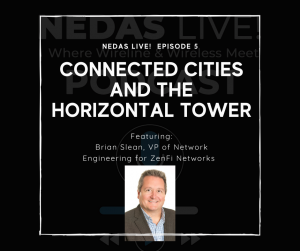
NEDAS, a grassroots association at the intersection of wireline and wireless with a goal of improving communications infrastructure, is dedicated to enabling the connected world by promoting collaboration, discussion and education. To fulfill this goal, the association focuses on keeping its members and the wider telecom industry abreast of key insights and leading strategies. As demands on communications networks continue to dynamically evolve, staying up-to-date on the latest news and trends is vital to remaining on the smooth path to a future of smart cities, intelligent design and other emerging technology deployments. With fiber playing a critical role in the network and infrastructure ecosystem, touching base with experts in this sphere delivers critical advantages to the world of communications.
Episode five of the NEDAS Live! Podcast, hosted by Ilissa Miller, President of NEDAS and CEO of iMiller Public Relations, and Steve Yapsuga, Co-Chair of the NEDAS Advisory Council and North American Director of Sales for Comba Telecom, featured a discussion with Brian Slean, Vice President of Network Engineering for ZenFi Networks. ZenFi Networks, an innovative communications infrastructure company founded on the vision of creating a new type of network to solve the infrastructure challenges of mobile networks, leverages deep insight into the challenges of — and solutions to — changing network demands.
Slean acknowledges that the criteria of infrastructure was altered a few years ago. While the term used to encompass power, bridges and items of that nature, now, fiber optics in the ground, in the air and otherwise are now part of this category. Additionally, the return on investment for fiber optic is currently a lot higher than that of traditional infrastructure investments, so everyone wants in. However, ZenFi Networks differentiates itself by focusing on a fronthaul-based strategy. This method enables reach to the very edge, empowering densification and fragmentation of fiber footprints for the increased demands of 5G and related technologies.
In terms of the smart cities that remain on the horizon, applications like these underline the need for networks to not only stop and splice at major buildings, but at every manhole and pole top that they traverse. For traditional underground networks, it can be a challenge to accomplish these stops at every street corner. Luckily, solutions such as using one conduit in the ground to connect to multiple different places helps networks overcome mobility challenges.
Massive bandwidth drivers such as self-driving or even self-parking cars go hand-in-hand with this challenge, as all the bandwidth needs to go somewhere. Building receptors and focusing on the ‘horizontal tower’ is key here. Instead of going to a large macro tower, in which all data goes back to a cell tower, now networks are heading in a direction of creating that effect horizontally down any given street. This means radios on light poles, street furniture and just about everywhere else possible.
All in all, as the industry moves toward the future and works on accommodating evolving and rapidly expanding requirements, coverage remains key. It will take some innovative network topologies and strategies to achieve the level of densification necessary, but disruptors in the world of telecom are already laying the groundwork and implementing networks of the future.
To read the previous blog about NEDAS Live! Episode four, please click here.
To learn more about NEDAS, please visit www.nedas.com.
To learn more about the NEDAS Live! Podcast or submit yourself for consideration to appear on an episode, please click here.





